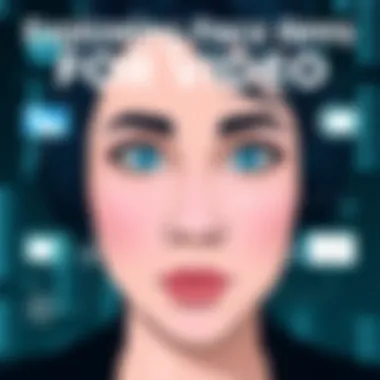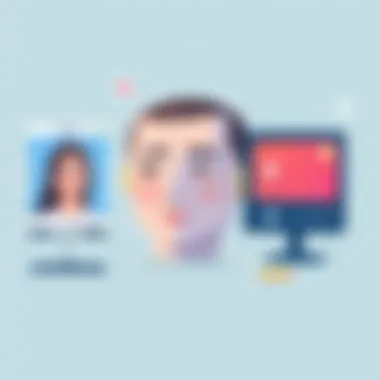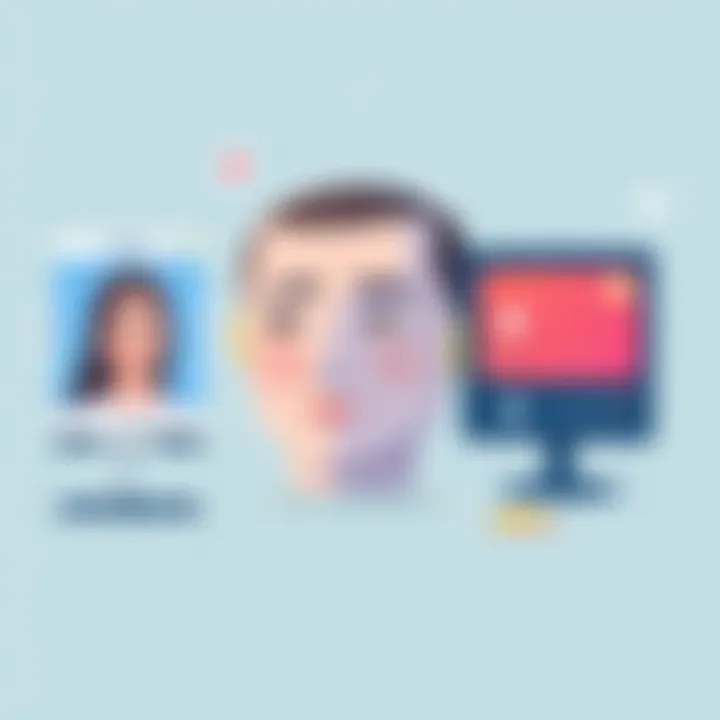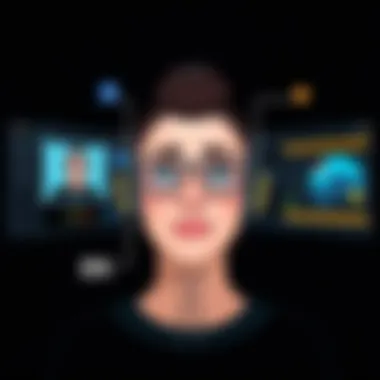Exploring Face Apps in Video Production: Features and Trends


Intro
As technology races ahead, the landscape of video production is undergoing a seismic shift driven by innovations in software that alter how we present our faces on camera. Face apps developed for video capture not only serve the purpose of enhancement but also weave narratives that extend well beyond aesthetics. This exploration dives into the world of these face apps, breaking down their features, implications, and trends that shape the future of visual storytelling.
From broadcasting platforms to social media and content creation, the increasing sophistication of these tools offers users the power to transform, enhance, and sometimes distort their visual presence. This trend prompts discussions around identity, ethics, and societal perceptions, which will be crucial to untangle. An understanding of both their capabilities and limitations is essential for anyone interested in harnessing these lively tools.
In this guide, we aim to dissect various aspects of face apps, bridging the nexus between technological advancement and real-world application. With a focus on relevant and timely insights, we will address key characteristics, user experiences, ethical dilemmas, and the future trajectory of these compelling tools.
Let’s embark on this journey through the exciting realm of face apps in video content.
Preface to Face Apps in Video
The rise of face apps specifically designed for video content has reshaped the landscape of digital media, merging artistry with advanced technology. These applications have practically turned everyday users into semi-professional editors, allowing anyone with a smartphone or computer to manipulate their appearance or enhance videos with a few taps. The ease of access and the powerful features that these apps offer make them significant not only for individual users but also for brands and content creators. The importance of face apps goes beyond mere entertainment; they represent an evolving aspect of personal expression, creativity, and social interaction.
Face apps blend visual technology with user experience by utilizing intricate algorithms and machine learning techniques. This colloquial enhancement doesn’t merely revolve around playing with filters or adjusting hues but extends into realms of augmented reality and artificial intelligence. From subtle enhancements to dramatic alterations, these apps offer a plethora of possibilities that can transform how we interpret our own images and those of others. As we dive deeper into this phenomenon, it’s crucial to consider several distinctive elements.
Defining Face Apps
Face apps are software tools that manipulate the appearance of an individual’s face in videos or photos using various techniques like facial recognition and filtering. These apps serve a wide spectrum of purposes—from beauty enhancement to cinematic storytelling. Take, for instance, the rise of platforms like Snapchat and Instagram, which prioritize face filters and effects that can warp familiar visual narratives. They allow users to augment reality by changing facial features, adding animations, and even altering backgrounds—all while maintaining an interactive experience.
Each app carries its unique flair, providing customizable features that can adapt to the user’s preferences. This makes defining face apps a bit slippery; they aren't just tools but rather creative interfaces that open up new artistic avenues for both casual users and seasoned professionals.
Evolution of Video Editing Software
Tracing the evolution of video editing software reveals the technological advancements that have given rise to face apps. In the late 20th century, editing software primarily focused on cutting and rearranging clips, requiring in-depth technical expertise. As the internet expanded and digital technology took off, video editing became accessible to the masses. Programs like Adobe Premiere and Final Cut Pro paved the way for non-linear editing, where creative possibilities blossomed.
Fast forward to the current era; the demand for user-friendly interfaces has soared. As a result, face apps emerged as a formidable faction within video editing—blurring the boundaries between amateur and professional content creation. These apps leverage advanced algorithms for real-time processing, allowing users to implement complex effects that would have taken hours of editing just a decade ago.
This shift signifies more than just convenience; it has democratized creativity, enabling anyone, regardless of technical skill, to experiment with video in ways previously thought exclusive to industry insiders. As the technology continues to evolve, we find ourselves at the frontier of what’s possible in video production, with face apps sitting right at the core of these innovative developments.
Core Features of Face Apps
Understanding the core features of face apps is crucial for those delving into the world of video content creation. These functionalities not only shape how users interact with their video but also influence the overall quality and efficiency of their production processes. Face apps offer a suite of tools that enhance user experiences, making videos more engaging while also presenting certain considerations regarding their use.
Facial Recognition Technology
Facial recognition stands at the forefront of these applications. This technology allows the software to identify and track human faces, a testament to the advancements in machine learning and artificial intelligence. By analyzing distinct facial features and expressions, apps can apply filters, effects, or alterations based on the person in the frame.
The implications for usability are significant. For creators, this means higher quality content and more personalized experiences. For instance, an app might recognize a user’s face and apply a specific filter that suits their features, enhancing the video without overwhelming it with effects. However, it is essential to consider the privacy and data security aspects of such technology. As users upload content, they relinquish some degree of control over their biometric data, which can raise eyebrows in terms of ethical use.
Real-time Video Enhancement
Another critical feature is real-time video enhancement. Unlike traditional editing methods that require significant post-production work, real-time capabilities allow users to see the effects of their choices instantly. This immediacy can transform the video-making process, decreasing time spent on editing and increasing the creative flow. Apps that streamline the video enhancement process can elevate content quality to a professional level without demanding extensive technical skills from the user.
Imagine a vlogger capturing a sunset. With real-time enhancements, they can adjust brightness, contrast, or even apply filters while recording. This ability not only enriches the visual appeal but also opens a plethora of creative avenues right on the spot. Yet, creators must balance these enhancements with authentic content production, keeping their audience's trust at the forefront. Crafting an engaging narrative shouldn't be lost amidst a sea of shiny effects.


Customizable Filter Options
The customizable filter options found in many video apps empower users to express their personalities and artistic styles. Users can select from a vast library of presets or create their own filters tailored to specific projects. This versatility offers a more bespoke approach, enabling creators to match their video aesthetics with the message they want to convey.
While these filters can significantly improve the visual impact of a video, they also present a double-edged sword. Over-reliance on filters may risk diluting genuine content. It's crucial for users to maintain clarity and authenticity, balancing creativity with sincerity. A well-chosen filter can elevate a video, but excessive or inappropriate use risks alienating viewers.
In summary, the core features of face apps, including facial recognition, real-time enhancement, and customizable filters, not only add depth to video content but equally invite a suite of considerations. Understanding these elements is paramount for creators aiming to leverage technology effectively, striking the right balance between engaging content and ethical responsibility.
"In the rapidly evolving landscape of video technology, knowing the tools at one's disposal is half the battle."
These features lay the groundwork for a richer, more compelling video experience, encouraging tech-savvy individuals to explore the potential while remaining vigilant about the implications.
Popular Face Apps in Video Applications
In the realm of video production, the emergence of face apps has dramatically shifted industry standards. These applications not only enhance visual aesthetics but also provide content creators with powerful tools to shape viewer perceptions. Understanding popular face apps is paramount for anyone looking to harness technology effectively in their video projects. They offer a range of functionalities that go beyond mere novelty, impacting professional outcomes and personal reflections alike.
Overview of Leading Applications
There are various popular face apps currently making waves in the video arena. Here’s a closer look at some leading applications:
- Snapchat: Known for its innovative AR features, Snapchat offers a variety of filters that can significantly alter individual appearances in real-time videos.
- FaceApp: While primarily known for its aging filter, it also includes features that allow users to change hairstyles and apply makeup, all of which can bring a creative spark to video projects.
- Reface: This unique app specializes in face-swapping technology, permitting users to insert their likeness into scenes from films or famous music videos, turning videos into fun, shareable moments.
- TikTok: Beyond being a social media giant, its built-in features like face tracking and effects provide users with endless creative possibilities for engaging short video formats.
Each of these apps possesses a distinctive flair. However, the implications of their use should be seriously considered. The appeal lies not just in their user-friendly interface but also in how they redefine user engagement and creativity in video applications.
Comparative Analysis of Features
When diving into face apps, it’s crucial to evaluate their features, as this will influence which app best suits a creator’s needs. Below, a comparative analysis highlights how various apps stack up against each other:
- Facial Recognition Accuracy: Applications like Snapchat excel with sophisticated facial recognition technology that adapts seamlessly to various lighting conditions and angles, enriching the user experience.
- Real-Time Filters: While FaceApp allows for extensive customization after video recording, TikTok’s real-time filter application fosters spontaneous creativity, enabling users to experiment with changing effects on-the-fly.
- User Collaboration: Some apps, like TikTok and Snapchat, provide collaborative features, allowing users to join together in video projects, fostering community interaction.
Understanding these features is not just about grasping technical specs—it’s about seeing how they enhance storytelling in your visual content.
User Experience and Implications
In today’s fast-paced digital world, user experience and the implications of face apps play a crucial role in shaping how individuals interact with video content. The use of advanced technology in facial manipulation opens new doors for creativity and communication. As such, understanding the nuances of user experience in this context not only highlights the value face apps bring to content creators but also raises important considerations regarding accessibility, usability, and ethical concerns.
Impact on Content Creators
Face apps have radically transformed content creation for many users. For one thing, they allow creators to enhance their videos in ways that were once the realm of high-budget productions only. Consider influencers on platforms like Instagram or TikTok, who often rely on these tools to maintain their brand image and engage their audience. By using features like virtual makeup or animated facial effects, creators can produce content that stands out in a crowded marketplace. This not only boosts their visual appeal but also increases engagement rates significantly.
Moreover, the ease of use in many of these applications encourages creativity. Users can experiment with different styles and approaches without the steep learning curve typically associated with video editing software. This democratization of technology means that anyone with a smartphone can potentially create professional-looking content. Also, as face apps integrate with popular social media platforms, the potential for virality becomes more attainable. This is especially true when trends emerge, encouraging users to hop on challenges that require creative video alterations.
Yet, with great power comes great responsibility. The impact of such tools extends beyond mere aesthetics. As face apps become more integrated into the content creation sphere, they might alter public perception of beauty standards. Some might argue that these enhancements lead to unrealistic expectations and distort self-image among viewers. It’s vital for creators to remain mindful of how they portray themselves and influence their audience.
User Accessibility and Adoption
As face apps become more widely accessible, their adoption by a diverse range of users is also on the rise. The user-friendly interfaces of these applications make them appealing to a broad audience, from hobbyists to seasoned professionals. Notably, many face apps require minimal technical skills, allowing newcomers to jump right in with a few taps. This could potentially lead to a scene where anyone can share their narratives visually, breaking barriers of creativity while fostering a new culture of inclusivity.


Accessibility is particularly significant for differently-abled individuals. For example, certain apps have features designed to assist users with hearing impairments, using overlays of text or visual symbols that can replace audio cues. This inclusiveness not only enriches the variety of expressions in video content but also expands the user base.
However, not every user has access to the latest technology or high-end smartphones. The effectiveness of face apps can often hinge on hardware capabilities. While some apps might have basic functionalities that run on older devices, more advanced features may remain locked for newer models. Thus, while the potential for widespread adoption exists, realizing that not all users are on equal footing is crucial for developers aiming for inclusivity.
In summation, the experience of using face apps for video creation opens up a vibrant world of possibilities but also demands a careful approach to ethical implications and technological accessibility. As the landscape continues to evolve, both users and developers must remain cognizant of the delicate balance between creativity and responsibility.
"With great power comes great responsibility, and this holds true as we navigate the world of advanced digital content creation."
For further reading on user experience in technology, visit Wikipedia or check out insights from Forbes.
By continuously diving into user experiences and their broader implications, we can appreciate the fine line between innovation and ethicality.
Ethical Considerations in Face Apps
As face apps continue to shape the landscape of video production, the ethical ramifications tied to their use come into sharp focus. It’s vital to ponder upon the dual-edged nature of these technologies—while they offer groundbreaking functionalities, they also raise alarm bells when it comes to privacy, representation, and the potential for misuse. Inadequate scrutiny in these areas might lead to consequences that echo far beyond the screen.
Privacy Concerns
In this digital age, privacy is a cornerstone that individuals value dearly yet feel like they are losing bit by bit. Face apps often require a comprehensive access to personal data, which may include facial recognition features that analyze users’ biometric details. Information like which images and videos are analyzed can be collected and stored, creating a database that could theoretically be exploited if not properly managed.
- Personal Data Usage: Users frequently overlook how their data will be utilized, sometimes agreeing to terms that allow companies to share or sell the information to third parties.
- Potential for Surveillance: With face apps in the hands of various entities, the risk of surveillance increases. The implications of governments or corporations using such technology to track individuals' movements and interactions cannot be dismissed lightly.
"The data collected through these apps is like a candy jar; without proper transparency, individuals are essentially left in the dark, unaware of what portions may be taken by others." A robust data protection law might help ensure users remain in control of their own information.
Misrepresentation and Deception
Misrepresentation through face apps poses one of the more troubling ethical dilemmas lurking beneath the surface. When users apply filters to alter their appearance significantly, it raises questions about authenticity and trust in online interactions. For example, a content creator may present a version of themselves that doesn't genuinely reflect their real looks, potentially misleading followers.
- Real-world Consequences: This deception can have cascading effects, particularly among younger individuals who might struggle with self-image. When societal norms are set based on distorted realities, it can lead to detrimental mental health issues.
- Market Impact: Influencers and brands risk reputational damage when their products or personas are misrepresented. The credibility once held may evaporate in the blink of an eye, leading to both fans and consumers feeling duped.
The discussions surrounding misrepresentation challenge the notion of authenticity that is often celebrated in the digital realm. The fine line between artistic expression and deceit can blur quickly, proving that while face apps provide options for enhancement, their implications must be considered seriously to foster a healthy digital ecosystem.
As we further explore the capabilities and challenges presented by face apps, awareness of these ethical considerations remains integral in steering the conversation toward a more responsible usage of technology.
Technological Challenges
The rapid rise of face apps in video production doesn't come without its set of technological barriers. Understanding these challenges is vital for assessing the overall effectiveness and future potential of these applications. While they promise a lot, the technologies behind face apps also need careful examination. Two noteworthy challenges stand out: performance limitations and quality versus speed trade-offs.
Performance Limitations
Performance limitations are often the elephant in the room when discussing face apps. These applications rely heavily on real-time processing capabilities, which are fueled by advanced algorithms and significant computational resources. In simpler terms, if the hardware can't keep up, user experience takes a nosedive.
Many users have encountered frustrating lag when applying filters or enhancements. This is particularly evident on older devices with less powerful chips. Moreover, even high-end devices can stumble under the pressure if running multiple apps simultaneously. This brings about a rather unsatisfactory interaction, sometimes skewing the very purpose of using such advanced tools in the first place.
When performance is compromised, the result isn't just cumbersome - it's a matter of nailing the essence of the content community. Creative production can quickly turn tedious, and awkward silences fill the editing space. Creators often end up choosing between lowering the visual effects’ complexity or waiting for the app to catch up, compromising on their artistic vision.
Quality vs. Speed Trade-offs


Another intricate dance unfolds in the realm of quality versus speed. Face apps, by their nature, strive to deliver stunning results quickly, but each time the speed is ramped up, the risk of sacrificing quality lurks around the corner. The phrase, "You can't have your cake and eat it too," perfectly epitomizes this situation in the tech landscape.
Users frequently report that while a filter may apply quickly, the final product can often lack the polish and finesse expected. For example, in social media contexts where instant sharing is king, creators are under immense pressure to produce visually appealing content fast. However, such haste can lead to pixelated images or awkward facial distortions.
In a world where content is king, striking the perfect balance between quality and speed remains a Herculean task. It requires developers to innovate continuously, seeking out solutions that uphold the bar without forcing users to compromise on their creative pursuits.
In summary, as face apps continue to carve out their space in video editing and production, challenges associated with performance and the delicate balance of quality and speed will influence their evolution significantly. Understanding these challenges is essential not just for users but for developers aiming to enhance and refine their offerings in the face of growing demand.
For a more in-depth overview of this technology, you can explore resources such as Wikipedia, or for a technical breakdown, Britannica provides valuable insights.
Future Trends in Face Apps for Video
The future of face apps in video promises to be a fascinating journey, not just for content creators but for everyone who interacts with digital media. As we increasingly blend our lives with technology, understanding what lies ahead becomes paramount. We're talking not just about flashy filters or amusing effects, but profound implications in content creation, security, and even social interaction.
Emerging Technologies
To grasp how face apps are evolving, we have to look at emerging technologies that are shaping this field.
- AI and Machine Learning: The backbone of most innovations in face apps is Artificial Intelligence. Machine learning algorithms now enable apps to recognize facial features with striking accuracy. This technology is advancing quickly, allowing for better contextual understanding of images. The future holds potential for even more sophisticated AI-driven enhancements that can adapt and personalize effects based on user preferences.
- Augmented Reality (AR): As AR technology improves, face apps can create seamless integrations of facial effects within our real-world environments. Applications are exploring the use of AR to overlay digital content on real-time footage, enhancing the viewing experience of various media forms. Such capabilities might not just entertain but also educate, offering interactive experiences to the users.
- 3D Face Mapping: Current face apps primarily work with 2D images. However, 3D mapping is on the rise, allowing for more realistic and immersive video transformations. This provides a depth to video editing that was previously considered the realm of high-budget productions. Expect to see more apps adopting this, giving users a chance to create content that feels truly lifelike.
"The fusion of face apps with emerging technologies will redefine how we view and interact with digital content in the years to come."
Potential Market Developments
The market landscape for face apps in video is changing rapidly. Various factors point towards promising developments:
- Increased Adoption Among Consumers: As technology becomes more accessible, expect a surge in users experimenting with face apps in personal videos and social media. Accessible technology can bring about a wave of user-generated content, fostering creativity among the general populace.
- Integration with Social Platforms: Many social media platforms are already integrating face app features into their offerings. Companies like Facebook and Snapchat have paved the way, but there’s untapped potential on platforms like TikTok and Instagram. This integration may spur a multi-platform content creation trend where one video can seamlessly move across platforms without losing its charm.
- Monetization Opportunities: As the popularity grows, so do monetization strategies. Faces apps may offer premium features that can contribute to brand partnerships. Influencers and content creators would find these useful for enhancing sponsored content, thus expanding their market reach.
- Collaborations with Brands: Expect partnerships between face app developers and popular brands, providing users with branded filters and effects that help promote products in engaging ways. This can transform advertisement into an interactive experience that resonates with the audience.
Culmination
As the curtain falls on our in-depth exploration of face apps in video, it becomes clear that this technology is not just a fleeting trend, but a transformative force within digital content creation. The significance of this topic can be distilled into several key elements that highlight why understanding face apps is crucial for both casual users and professionals alike.
Summary of Insights
Throughout this article, we've dissected the core features that make face apps invaluable tools in the realm of video production. From facial recognition technology that allows for instant adjustments to skin tones and facial structures, to real-time video enhancement that offers creators the ability to perfect their visuals on the fly, it's evident that these apps open up new avenues for creativity.
In addition, the customizable filter options present a straightforward means of personal expression, allowing users to generate distinct styles that can engage audiences effectively. Such capabilities not only elevate content but also drive viewer interaction, thus enhancing user experience significantly.
However, it’s essential to recognize the ethical considerations tied to these advancements. Privacy concerns and the potential for misrepresentation are growing issues, casting a shadow over the excitement these technologies bring. As we’ve discussed, navigating these waters requires a balance between leveraging innovation and maintaining ethical integrity.
Call for Further Exploration
In closing, while we have touched upon numerous facets of face apps, there is a vast ocean of undiscovered territory lying beyond this initial overview. Future research could delve deeper into how emerging technologies might better secure privacy without stifling creativity. Also, the social implications of these tools on mental health and societal perceptions of beauty warrant scrutiny. As we move forward, it's vital for tech enthusiasts and professionals to remain vigilant, staying informed of these developments and engaging in discussions surrounding the responsibilities that come with powerful tools.
As the landscape of video production continues to evolve rapidly, so too must our understanding and adaptation to these tools. The future of face apps will likely expand far beyond our current imaginings, pioneer new forms of storytelling, and perhaps even reshape how we interact with visual media on a fundamental level.
"The tools of creativity will always evolve, but the fundamental human experience of sharing our stories will remain timeless."
With that perspective, let’s carry forth our curiosity and drive for innovation, remaining open to what the future holds.
For additional insights on face apps and technological advances, consider checking resources such as Wikipedia, or explore discussions on platforms like Reddit.
As you step away from this article, remember the importance of both staying informed and sharing your findings with others. The story of face apps in video is just beginning.



